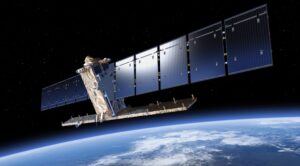Hope fading for recovery of European radar imaging satellite
Monday, 21 March 2022 08:36
ESA officials said prospects are dimming for the recovery of a radar imaging satellite that malfunctioned nearly three months ago, but that efforts to save the spacecraft continue.
The post Hope fading for recovery of European radar imaging satellite appeared first on SpaceNews.
Surviving space: major conference focuses on materials in space environment
Monday, 21 March 2022 07:05
Materials make the space mission – but ensuring they survive in space is always a challenge. The very act of transporting them beyond Earth ensures their characteristics will alter as they interact with the space environment in complex ways.
Beyond Gravity doubles production capacity for satellite dispensers
Monday, 21 March 2022 04:06
Beyond Gravity (formerly RUAG Space) is doubling its production capability of satellite dispensers in Linköping, Sweden, with the construction of a new facility.
The post Beyond Gravity doubles production capacity for satellite dispensers appeared first on SpaceNews.
Cyber warfare gets real for satellite operators
Sunday, 20 March 2022 21:52
The U.S. government on March 17 advised satellite operators to put their guard up in the wake of a cyberattack that disrupted internet services in Europe provided by Viasat’s KA-SAT.
The post Cyber warfare gets real for satellite operators appeared first on SpaceNews.
SpaceX launches 53 Starlink satellites after weather delays
Sunday, 20 March 2022 10:04 Elon Musk's SpaceX launched 53 Starlink satellites from Florida early Saturday morning after the launch was postponed Friday night because of stormy weather.
The launch, which came days after the company celebrated its 20th anniversary, was pushed back to 12:42 a.m. EDT when stormy weather near Complex 40 at Cape Canaveral Space Force Station had cleared.
The spacecraft was initi
Elon Musk's SpaceX launched 53 Starlink satellites from Florida early Saturday morning after the launch was postponed Friday night because of stormy weather.
The launch, which came days after the company celebrated its 20th anniversary, was pushed back to 12:42 a.m. EDT when stormy weather near Complex 40 at Cape Canaveral Space Force Station had cleared.
The spacecraft was initi General Dynamics’ cloud contract with NGA moves forward after Leidos withdraws protest
Saturday, 19 March 2022 15:54
General Dynamics won a 10-year deal with a $4.5 billion ceiling to modernize the National Geospatial Intelligence Agency's cloud infrastructure
The post General Dynamics’ cloud contract with NGA moves forward after Leidos withdraws protest appeared first on SpaceNews.
SpaceX sets reuse and payload mass records in Starlink launch
Saturday, 19 March 2022 15:09
SpaceX set records for the reuse of its Falcon 9 booster and the mass that rocket placed into orbit March 19 with the latest launch of Starlink satellites.
The post SpaceX sets reuse and payload mass records in Starlink launch appeared first on SpaceNews.
NASA's Perseverance rover hightails it to Martian Delta
Saturday, 19 March 2022 11:04 The rover's self-driving capabilities will be put to the test this month as it begins a record-breaking series of sprints to its next sampling location.
NASA's Perseverance Mars rover is trying to cover more distance in a single month than any rover before it - and it's doing so using artificial intelligence. On the path ahead are sandpits, craters, and fields of sharp rocks that the rover
The rover's self-driving capabilities will be put to the test this month as it begins a record-breaking series of sprints to its next sampling location.
NASA's Perseverance Mars rover is trying to cover more distance in a single month than any rover before it - and it's doing so using artificial intelligence. On the path ahead are sandpits, craters, and fields of sharp rocks that the rover SpaceX puts another 53 Starlinks in orbit with midnight launch
Saturday, 19 March 2022 11:04 Elon Musk's SpaceX launched 53 Starlink satellites from Florida early Saturday morning after a short delay. The company was scheduled to launch the spacecraft on a Falcon 9 rocket at 11:23 p.m. EDT from Complex 40 at Cape Canaveral Space Force Station. Liftoff time was instantaneous, meaning any problems could prompt a delay of about 24 hours to Saturday night.
Elon Musk's SpaceX launched 53 Starlink satellites from Florida early Saturday morning after a short delay. The company was scheduled to launch the spacecraft on a Falcon 9 rocket at 11:23 p.m. EDT from Complex 40 at Cape Canaveral Space Force Station. Liftoff time was instantaneous, meaning any problems could prompt a delay of about 24 hours to Saturday night. A large solar storm could knock out the power grid and the internet
Saturday, 19 March 2022 11:04 On Sept. 1 and 2, 1859, telegraph systems around the world failed catastrophically. The operators of the telegraphs reported receiving electrical shocks, telegraph paper catching fire, and being able to operate equipment with batteries disconnected. During the evenings, the aurora borealis, more commonly known as the northern lights, could be seen as far south as Colombia. Typically, these light
On Sept. 1 and 2, 1859, telegraph systems around the world failed catastrophically. The operators of the telegraphs reported receiving electrical shocks, telegraph paper catching fire, and being able to operate equipment with batteries disconnected. During the evenings, the aurora borealis, more commonly known as the northern lights, could be seen as far south as Colombia. Typically, these light Report to Congress on Hypersonic Weapons
Saturday, 19 March 2022 11:04 The United States has actively pursued the development of hypersonic weapons-maneuvering weapons that fly at speeds of at least Mach 5-as a part of its conventional prompt global strike program since the early 2000s. In recent years, the United States has focused such efforts on developing hypersonic glide vehicles, which are launched from a rocket before gliding to a target, and hypersonic crui
The United States has actively pursued the development of hypersonic weapons-maneuvering weapons that fly at speeds of at least Mach 5-as a part of its conventional prompt global strike program since the early 2000s. In recent years, the United States has focused such efforts on developing hypersonic glide vehicles, which are launched from a rocket before gliding to a target, and hypersonic crui New insight into the possible origins of life
Saturday, 19 March 2022 11:04 Researchers at the University of Tokyo have for the first time been able to create an RNA molecule that replicates, diversifies and develops complexity, following Darwinian evolution. This has provided the first empirical evidence that simple biological molecules can lead to the emergence of complex lifelike systems.
Life has many big questions, not least being where did we come from? Mayb
Researchers at the University of Tokyo have for the first time been able to create an RNA molecule that replicates, diversifies and develops complexity, following Darwinian evolution. This has provided the first empirical evidence that simple biological molecules can lead to the emergence of complex lifelike systems.
Life has many big questions, not least being where did we come from? Mayb Black swifts descended rapidly during lunar eclipse
Saturday, 19 March 2022 11:04 An international research team led by Lund University in Sweden has managed to study the flight behaviour of the mysterious black swift. They found, among other things, that the black swift rises to extreme heights during a full moon, seemingly catching insects in the moonlight. And, during a lunar eclipse, the birds simultaneously lost altitude. The results are published in Current Biology.
An international research team led by Lund University in Sweden has managed to study the flight behaviour of the mysterious black swift. They found, among other things, that the black swift rises to extreme heights during a full moon, seemingly catching insects in the moonlight. And, during a lunar eclipse, the birds simultaneously lost altitude. The results are published in Current Biology. NASA spots giant debris cloud created by clashing celestial bodies
Saturday, 19 March 2022 11:04 Major smashups between rocky bodies shaped our solar system. Observations of a similar crash give clues about how frequent these events are around other stars. Most of the rocky planets and satellites in our solar system, including Earth and the Moon, were formed or shaped by massive collisions early in the solar system's history. By smashing together, rocky bodies can accumulate more material,
Major smashups between rocky bodies shaped our solar system. Observations of a similar crash give clues about how frequent these events are around other stars. Most of the rocky planets and satellites in our solar system, including Earth and the Moon, were formed or shaped by massive collisions early in the solar system's history. By smashing together, rocky bodies can accumulate more material, Government of Canada invests in small modular reactor technology
Saturday, 19 March 2022 11:04 Canada is a leader in nuclear energy and nuclear safety and has one of the world's most promising domestic markets for the safe and responsible development of small modular reactor (SMR) technology. SMRs have the potential to provide strong economic benefits to the Canadian economy and support Canada's efforts to achieve net-zero greenhouse gas emissions by 2050.
The Honourable Francois-Ph
Canada is a leader in nuclear energy and nuclear safety and has one of the world's most promising domestic markets for the safe and responsible development of small modular reactor (SMR) technology. SMRs have the potential to provide strong economic benefits to the Canadian economy and support Canada's efforts to achieve net-zero greenhouse gas emissions by 2050.
The Honourable Francois-Ph 